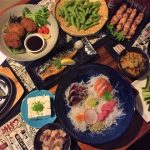Aizu-Wakamatsu (Fukushima)
Aizu-Wakamatsu and Ouchijuku (Fukushima)
Aizu-Wakamatsu (or simply Aizu) in Fukushima is a samurai town with a rich history. The historical atmosphere of the town works in perfect harmony with the stunning natural scenery. Aizu can be reached by a bullet train and express train from Tokyo in approximately 3 hours.
There are two major onsen (hot spring) regions close to the city – Higashiyama Onsen (only a 10-minute drive) and Ashi-no-maki Onsen (approx. 25-minute drive). Why not take the time to deeply explore the history of the town while staying at the tranquil onsen, surrounded by beautiful nature.
Where’s the best spots in Aizu-Wakamatsu? (Must see)
Tsurugajo Castle: The castle is a landmark of Aizu. It was originally built in 1384 by Ashina Naomori. The original castle was dismantled in 1874 after the Boshin Civil War (the Japanese Revolution). In 1965, the current castle was reconstructed. Tsurugajo stands in a 90-acre park, with around 1,000 cherry blossom trees and more than 2,000 keyaki (Japanese zelkova) trees. Here you can see the beautiful seasonal colours such as cherry blossom pink in spring, fresh greenery in summer and fiery red leaves in autumn.
Oyakuen Garden: Located only 15 minutes on foot from the castle, this gorgeous Japanese garden, with its seasonal flowers and plants, used to be a medical herb garden.
Aizu Bukeyashiki: This samurai residential complex museum contains 38 rooms in approx. 7930sqm of total ground floor area! Here you can witness the higher ranked samurai’s life and learn the culture and history of Aizu.
Mt Imori area
Sazae-do: Sazae-do is officially called Entsusanso-do and is designated as a national important cultural property. The three storied, hexagonal Buddhist temple hall has a height 16.5 metres and was built in 1796. The structure is unique in that it has two completely separate spiral staircases (one for going up and one for going down) which never meet each other.
Museum and Graves of the Byakko-tai, White Tiger Force: The Byakko-tai, White Tiger Force, is one of the brigades of the Aizu army set up to defend the town in the Boshin War. It consisted of 300 soldiers – the 16-17-year-old sons of the samurai. At the time when the castle was besieged, a group of twenty boys of the Byakko-tai retreated from a separate battle and reached the peak of Mt Imori. They saw that the castle was engulfed in black smoke. Thinking that the castle had fallen, they committed ritual suicide. In fact, the fire was in the castle town and not the castle itself.
This place has become well known for the story of the loyalty and tragedy of the Byakko-tai. There was only one survivor of the 20 boys, Iinuma Sadakichi, and it thanks to him that we can tell this story today.
Nisshin-kan: Nisshin-kan was the highest educational institution that the Aizu Clan had. Its purpose was to produce elite members of society. The sons of samurai families entered the Nisshin-kan when they turned ten. The facilities included a gym for martial arts, an observatory, the oldest school pool in Japan, and more. You can see the stunning architecture of the Edo period, as well as the schooling methods of the Nisshin-kan. There are also several hands-on activities such as Japanese archery, zen practice, painting local crafts, and so on.
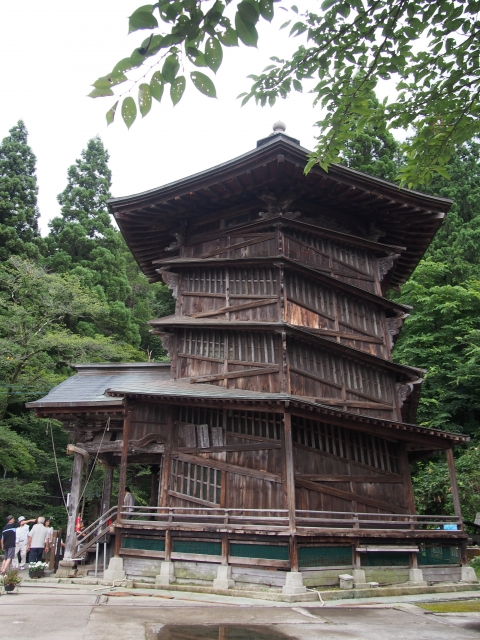
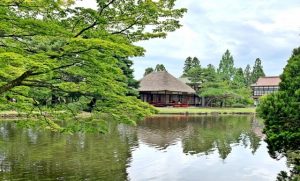
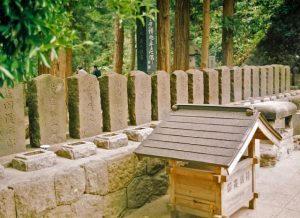
What else can you see in Aizu-Wakamatsu?
– Lacquer craft is one of the specialities of Aizu and there are some shops scattered around the town. Why not pop in to one and have a look the stunning artworks!
– Local Japanese sake is also a speciality. The brewery Suehiro Shuzo Kaei-gura has 170 years of history! Pop in for a tasting of their products. They also have a café so you can enjoy their unique café menu too!
– Erosoku. “e” means picture and “rosoku” is candle, so an erosoku is a candle decorated with pictures and this is also a famous local craft of Aizu. Beautifully decorated candles are also lovely artworks. You can have an experience of drawing on a candle (an appointment is essential) – or you may able to visit their workshop.
– Take a day trip to Ouchijuku, one of the station towns of the Shimotsuke Kaido trail (which is between Nikko and Aizu-Wakamatsu). This village was built in the Edo period (around 1640) and still retains its old historical streetscape.
In Ouchijuku, have Negi-soba (soba noodles with negi (Japanese leak)) for lunch – a local specialty. Well…..a whole negi is served with soba and you use it to eat the soba as well as take bites out of the whole negi – like a fresh condiment at the same time!! If you go to Ouchijuku, you must try it!
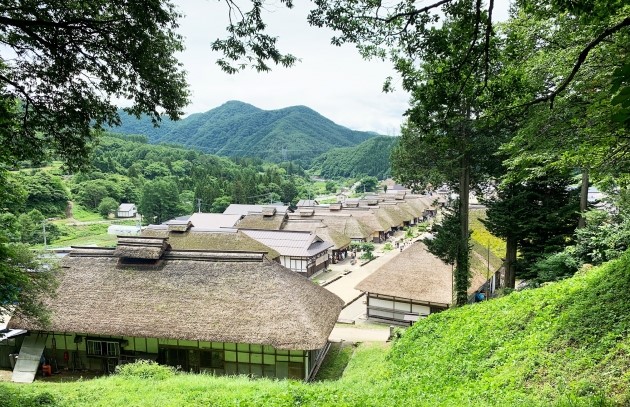
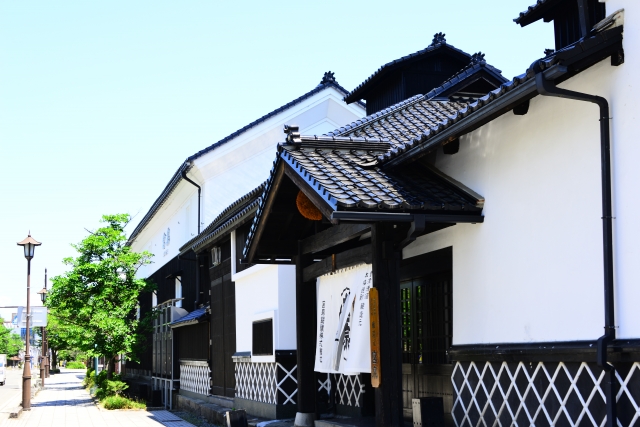
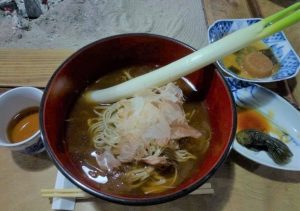
Local specialities (gourmet) with Unique experience
Wappa-meshi: “wappa” is a round shaped bento box made of Japanese cypress/cedar and “meshi” is rice. The rice is commonly cooked with dashi and topped with wild vegetables, lotus root, and salmon etc on the dashi flavoured rice.
Basashi: “ba” means horse and “sashi” is sashimi. Basashi is raw horsemeat thinly sliced and generally served with grated ginger, garlic and spring onions as fresh condiments, and with soy sauce. It’s a unique Japanese delicacy and even Japanese people don’t have it often. Aizu-Wakamatsu is one of the areas in Japan that produces horsemeat (Kumamoto, Kyushu is very famous for it), therefore some restaurants in Aizu can offer an opportunity to have fresh local basashi.
Kozuyu: A soup dish which is a typical Aizu regional cuisine. The soup is cooked and flavoured with dried scallop stock and soy sauce. The scallop is not only for dashi, but is also a filling for the soup along with root vegetables (potatoes, carrots, taro etc), gingko, shiitake mushrooms etc. Traditionally, kozuyu is served at a celebration or significant family/community events.
Aizu Sauce Katsu-don: Katsu-don is deep-fried, bread-crumbed pork cutlet on top of rice. Aizu sauce katsu is where the katsu (the fried pork) is stewed in their original tonkatsu sauce (which tastes like a cross between barbeque sauce and Worcestershire sauce) and then placed on top of a bowl of rice. It’s a favourite dish among the locals and it’s said that there are over 200 local restaurants that serve Aizu sauce katsu!
Kitakata ramen: If you’re a ramen lover you could take a day trip to Kitakata (about a half hour drive from Aizu-Wakamatsu), which is one of the famous ramen towns in Japan. Traditionally, “shoyu” soy sauce and chicken-based broth is the Kitakata ramen style!
Aka-beko: It’s not food, but a folk craft with over 400 years of history! Aka-beko (meaning red cow) is a traditional toy, as well as a lucky charm to protect against evil. It’s a must have souvenir of Aizu. There are several shops with a studio where you can have an experience of painting your own aka-beko. Why don’t you create a unique one for yourself as a lasting memory of your Japan trip!
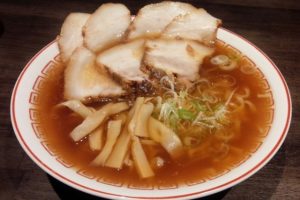
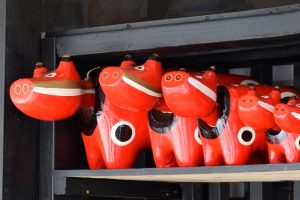
Meet rich history and culture in Aizu while exploring the fantastic Tohoku area!




